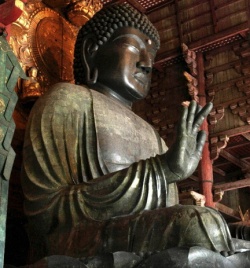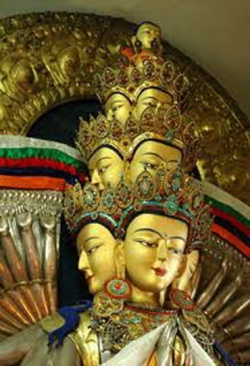Body of the Buddha -- Dhammakaya
Theravada tantra is concerned with a “mystic embryology” of generating the birth of the Buddha within the monks own body.
The monk transforms himself into the Buddha, “gives birth” to Buddha nature within himself.
This is achieved through memorization of dhamma texts, enactment of rituals to release and transform energies into dhammakaya, Buddha-Dhamma nature within the body.
“It serves no purpose to see the Buddha in his material body, in his corruptible body; he should be seen in his dhammakaya.” – Buddha.
The Buddha has two bodies, rupakaya (physical body) and dhammakaya, the body of his teaching.
There has been a historic tension in Theravada between those (A) who see the Buddha’s legacy on his teaching and (B) those who venerated in Buddha’s physical presence, his body in his lifetime; representatived often as his parinibbana.
The Khmer see dhammakaya as two inter-dependent meanings:
the body as the receptacle of the dhamma, and
the dhamma as the collective body of the Buddha’s teaching.
Theravada do not see the Dhammakaya and the Buddha-Dhamma as only metaphysical. “The Buddha image embodies the dhamma in a manner customarily associated with more esoteric forms of Buddhism that employ the ritual techniques of yantra and mantra.”
For a general study of Mantrayana in Theravada see L.S. Cousins “Aspects of Esoteric Southern Buddhism” in Indian Insights: Buddhism, Brahmanism and Bhakti, ed by Peter Connelly and Sue Hamilton, London: Luazac Oreintal 1997;
“The Several Bodies of the Buddha: Reflections on a Neglected Aspect of the Theravada Tradition”, History of Religion, Frank Reynolds, May 1977.]
“The dhammakaya also incorporates the equivalent of the thirty-two bodily parts of the great person (DII 16-17; MII 136-137) identified as the thirty-two kammatthana (bodily meditation subjects).
As the Buddha transformed his own body into the dhammakaya through the practice of kammathana” so also the monk’s meditation trance forms the material body of enlightenment, the Dhammakaya.
Swearer, Becoming The Buddha.
This happens also in the Buddha image consecration ceremony.
“In mainstream Theravada the term ‘dhammakaya’ is interpreted in an entirely non metaphysical way. It is the corpus of the Buddha’s teaching contained, preeminently, in the canonical writings of the Tripitaka.
For the esoteric tradition, however the concept has a special meaning. It is a transformed human body animated by the dhamma and understood as a series of sacred syllables.
This transformed body possesses super mundane qualities, the most important being the thirty-two marks of a great man.
To create this special body, the adept must use sound to awaken the crystal globe, or ‘infant in the womb,’ which is visualized in the region of the navel. Breathing exercises are also necessary.”
Mindfulness-With-Breathing meditation (anapanasati) is the workbench of this practice.
Passa (breathing in) denotes the wind that enters through the nose.
Assasa (breathing out) denotes the wind that exits from the nose.
Nissasa -- denotes the wind of the Abhidhamma of seven books, that is to say the wind that stops in the womb, at the level of the navel.
Visualization techniques are, of course, not unknown in Theravada, and Francois Bizot sees the origins of the practice in the canonical notion of a mind-made body (manomayakaya) that may be produced by a skillful meditator.
Notes on the visualization practice: The Apadana section of scripture, for example, has a lot to say about visualization practices.
Very similar teachings have been given new and popular currency in modern SE Asia through the Vijja Dhammakaya approach of Venerable Sot Chao Khun Phra Mongkol Thepmuni 1884-1959. The dhammakaya method is taught by the Mahanikaya Abbot of Wat Paknam Bhasicharoen, Thonburi.
A recent doctrinal theses by Metanando Bhikkhu has shown that the Dhammakaya teachings of Thailand do not originate with the founder of the modern movement, for he himself drew upon earlier sources. In particular, attention is drawn to the writings of Kai Thuean (1733-1832), a forest dwelling monk (arannavasi) from near Ayutthaya who was appointed patriarch by King Rama II in 1820.
Further inforamtion on "mind-made body" (manomayakaya) can be found in the Pali cannon: Maj ii.17 where the meditator comprehends that the material body is of the nature to be dissolved and decay, while the mind “is fastened there, bound there.”
In this sutta, the Buddha says: “I have directed disciples, practices which my disciples produce from this body another mental-body, mind made (manomaya as at Dhp1.1. Ma iii263 explains manena nibbattitam), having all its major and minor parts, not deficient in any sense-organ. (D.i.77; D I 34, 186, 195), as a man might draw an arrow from a reed, and might think thus: ‘This is the reed, this is the arrow, the reed is one thing, the arrow another. It is from the reed that the arrow has been drawn.’ Or it is as a man might draw a sword from a scabbard…or like a snake might come from its hole...even so….”
The most appropriate sounds to accompany these particular visualizations are those associated with the Buddha’s teachings, more specifically the initial syllables of the titles of the books of the Tripitaka;
A pa man cu: this is the quintessence of the books of the noble vinaya.
Di mam sam am u: the quintessence of the sutta.
Sam vi dha ppu ka ya pa: Seven books of abhidhamma
“To visualize the transformation of the fleshy body into that of the dhammakaya, one ritually plants each sacred sound in its allotted place.”
The Mahacunda Sutta (Aiii355-356) has an obscure early reference to the possibility of this tantric practice within the Tripitika itself.
The Sutta refers to the monk Cunda who reconciles two factions of monks, the dhammayoga bhikkhus and the jhati bhikkhus. The
dhammayoga bhikkhus practiced a speculative path.
The jhati bhikkhus practiced ecstatic meditation and “touched immortality with their bodies.”
In the Digha Nikaya, Sammanaphala Sutta, the Buddha says one of the “fruition of the holy life” is the “mind-made body” and a section ensues on how this is achieved; also creating supernormal powers (iddhi) in the process.
The dhammakaya (dharma-body) is discussed by Buddhagosa in Visuddhimagga VIII 23.
The Buddha brought his Dhammakaya to perfection of the treasured qualities of virtue, concentration, understanding, deliverance, knowledge and vision….
It has something to do with the supernormal powers.
The “mind-made body” is a product of super-normal power….hears divine sounds, sees divine sights, knows consciousness with penetration of mind….


